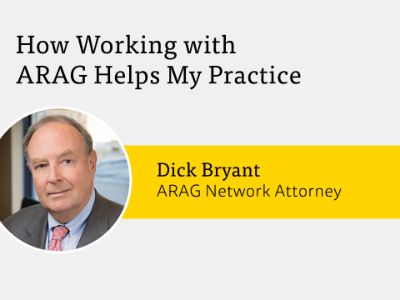As a solo practitioner, we have many hats we have to wear. Not only do we need to devote time and effort into serving our clients but we also need time for marketing, accounting and sometimes even tech support. I've been practicing bankruptcy law with my husband in San Francisco since 2009. It often feels as though I'm 30 percent lawyer, 30 percent social worker, 30 percent coach and 10 percent financial advisor to my clients.
I started practicing mindfulness and meditation in 2010 when I began to experience many tell-tale signs of burnout: chronic fatigue, insomnia and forgetfulness. I also started experiencing severe anxiety. My doctor confirmed that there was no physical cause of these symptoms and suggested I may want to try anti-anxiety medication. Intuitively, I felt that medication wasn't the right solution and sought an alternative treatment.
My friend, a psychotherapist, suggested I might want to look into the anxiety management clinic at Stanford University. Reluctantly, I completed their online intake form. A few weeks later, I was diagnosed with social anxiety disorder. I went through two different treatment programs — cognitive behavioral therapy and mindfulness-based stress reduction.
After almost seven years, I have many more tools in my toolbox for managing all the pressures of a law practice and I also became passionate about talking to other lawyers about these tools.
How I Use Mindfulness: ARAG Network Attorney Tracey Duval
An ARAG network attorney, Tracey Duval, who practices real estate, estate planning and bankruptcy in Chicago, IL, shared that the three stress-inducing parts of her law practice are technology, marketing and billing. She prides herself on customer service and typically responds to client emails and calls instantaneously. Tracey observed that, "when I'm stressed, I'll return non-urgent emails and client calls up to 48 hours after I receive them. I also eat bad, skip workouts and limit the fun things I do with family and friends."
In an effort to regulate her stress, she started meditating and practicing yoga in 2012. Additionally, she shared, "I've also started reading more fiction books — anything that will take my mind as far away as possible from my current worries."
What is mindfulness?
In his book The Mindful Brain: Reflection and Attunement in the Cultivation of Well-Being, Daniel J. Siegel, director of the Mindsight Institute and co-director of the UCLA Mindful Awareness Research Center, writes:
Mindfulness in its most general sense is about waking up from a life on automatic, and being sensitive to novelty in our everyday experiences. Mindful awareness, as we will see, actually involves more than just simply being aware: It involves being aware of aspects of the mind itself. Instead of being on automatic and mindless, mindfulness helps us awaken, and by reflecting on the mind we are enabled to make choices and thus change becomes possible.
Mindfulness is a particular state of mind, a way of being, a way to engage with the world. It's often defined as being aware of the present moment without judgment or preference. So often, we live in a place far away from this present moment. We may physically be here but our mind is someplace else. This can happen when you're at the office thinking about something that needs to be done at home; thinking about your child or your significant other; or having your mind be someplace else. Of course, the opposite can also happen. You may be helping your child with his homework and find your thoughts absorbed in some work situation.
Over the course of our lives, our minds become habituated to a constant stream of thoughts, worries, emotions, and memories that pull us away from being here — noticing the sensation of our feet on the ground, the voice of the person with whom we're speaking, the sunlight on our face.
Mindfulness is the practice of fully engaging and being in our life. With the internet, social media, email, smartphones and all the other constant distractions, it's easy to check out and miss life's precious moments. We can mistake busyness and distraction for productivity, genuine connection and quality time. In doing so, not only do we disengage from others, but we can easily disengage with ourselves.
I jokingly tell the attorneys who attend my mindfulness workshops that I started practicing mindfulness because I got tired of showering with all of my clients. Rather than focusing on the sensation of being in the shower, I'd run through my client list, feeling frustrated over a client who refused to follow my advice and then suffered the consequences of going against my advice. Of course, the client would often blame me for the exact outcome I warned him against.
During the first class in the mindfulness course at Stanford University, the teacher suggested we practice "mindful showering." Instead of having the mind busily in thinking mode, simply pause and pay careful attention to the sensations of being in the shower. This tiny shift was transformative. I began to see that the constant stream of thoughts — rumination, worrying, feeling frustrated, angry, etc. are simply habitual reactions of my mind. Often, the thoughts weren't based in reality or factually accurate.
Being more mindful doesn't happen overnight. It requires consistent effort. You can't demand or force your mind to be more mindful. Through meditation and other mindful practices, you train your mind to be more focused on the present moment and spend less time on unproductive, unhelpful thinking.
What is meditation?
Different people may mean different things when they refer to "meditation." While many meditation traditions come with philosophies, religious beliefs, rituals and specialized equipment, meditation itself is simply a form of mental training. All of the many different meditation practices that exist boil down to the same thing at their essence: they are all means of settling and focusing the mind. By sitting quietly with your own mind day after day, you get to know it better.
One reason meditation can have such a powerful effect on people's lives is because our mind is one of the very few things we have some ability to control. We may not be able to control what happens to us, but by getting to know ourselves and our own thought patterns better, we can learn to control how we react to and process the events in our lives — and developing this ability changes how we experience life. We can retain inner strength and a sense of well-being even in very difficult situations. We can savor life more fully when we aren't distracted by unnecessary worries about what might or might not happen in the future.
Building this kind of mental skill is particularly useful for lawyers, since we are always working to attain outcomes on behalf of our clients, and yet have limited control over those outcomes. We can't be certain of how the judge will react to our arguments, how our opposing counsel will receive our negotiating proposal, or even how the witness we've prepared will actually testify when faced with the spotlight of the courtroom. And, of course, we have no control at all over the facts that brought our client into our office in the first place.
Hundreds of studies have shown the benefits of meditation in reducing stress in a wide range of settings. Meditation training has been shown to have a measurable and continuing ability to reduce the experience and effects of stress even in people who are coping with such challenging situations as cancer treatment, HIV and chronic pain.
Scientific benefits of mindfulness and meditation
Much of the buzz around mindfulness and meditation has to do with the fact that we can now see how these ancient practices changes the brain. We no longer have to rely on the subjective experience of the meditators.
Jon Kabat-Zinn, an MIT-trained doctor and molecular biologist's work has shown that physiological changes begin to take place in the brain after only eight weeks of meditation practice. Studies have shown regions of the brain that are important for learning, memory and executive decision making grow measurably larger after meditating regularly in this relatively short timeframe, and that other areas of the brain, such as the amygdala, grow smaller. The amygdala, sometimes referred to as our "reptile brain," is involved in the fight or flight response, so the fact that it shrinks after even a relatively small amount of regular meditation practice suggests meditation can powerfully alter the way we deal with external threats and the extent to which we find ourselves living in fear.
Why mindfulness for lawyers?
The most critical skill one gains through mindfulness practice is awareness. Often, we can fall into bad habits, as Tracey noted: not eating right or not exercising, and often not even noticing it. It can feel as though life is so hectic and overwhelming that you're struggling not to drown.
Once you become aware, that opens the possibility of choosing your response. For example, you may notice that when you are feeling stressed, you tend to consume more fatty or sugary foods. It moves the habitual behavior from the automatic and subconscious into the open.
Another part of mindfulness is the practice of self-compassion. Once I started practicing mindfulness and became aware of the constant stream of thoughts, I was surprised to see how much negative self-talk I engaged in. I was setting unrealistic expectations for myself. Rather than using the carrot to motivate myself, I was constantly using the stick. Again, it was only through awareness that I was able to take a friendlier stance toward myself.
Mindfulness is particularly useful for lawyers because we tend to be highly cerebral. This is necessary for problem solving, researching and attending to our client's needs. However, much of the time we spend thinking isn't particularly useful. For example, you may be working on a motion and then recall a hearing you lost many years ago. Rather than notice you're caught up in the cycle of rumination, you may completely lose yourself in reliving this past experience, which is only taking up precious mental resources.
With regular mindfulness practice, you get better at worrying less over things that you do not have control over. This of course allows you to spend more of your mental resources focusing on the areas that you do have control over.
How I Use Mindfulness: ARAG Network Attorney Tom Amberg
Tom Amberg is a solo bankruptcy practitioner and ARAG network attorney in downtown Sacramento, CA. The top three most stress-inducing parts of his job are "managing the calendar, having multiple hearings at the same time (and in different locations) and clients who would like a significant amount of attention, day or night." Tom considers himself to be fairly stress-free but he knows he's under stress when "my to-do list grows to over one page. That usually means I haven't been effectively managing my time, or I've simply been too busy to get caught up on the little things."
Tom's most effective coping strategy is to take a walk. "I work very close to the state capitol park and I will often go for a quick walk. The park is almost exactly a mile, so a walk will take me 20-25 minutes. I like to listen to a podcast while doing this, then come back to my office having not thought about my work. It helps me approach problems differently and, at the very least, make sure that my Fitbit step count is where it needs to be!"
For many years, I had a very difficult and contentious relationship with a bankruptcy trustee. We simply didn't agree on anything and I found myself wasting time feeling angry, frustrated and obsessively thinking about what she would do next. We would engage in "email wars" where we'd waste days, sometimes weeks, firing one hostile email after the next.
As my mindfulness practice deepened, I was able to see more clearly that the way I was responding to the trustee wasn't helpful or productive. I started to reflect more deeply about the type of attorney I wanted to be and focus on what I had control over. I refused to get caught up in the email drama and disengaged from the pettiness. This actually allowed us to have a more civilized relationship and, of course, reduced the negative impact on my nervous system.
Surprisingly, the mindfulness practice allowed me to become a better listener. This has obvious positive impact in everyday life but it did in the courtroom as well. Rather than mentally "checking out" to prepare my response while the judge or the opposing counsel was still speaking, I was able to relax and fully pay attention to what was being said (and oftentimes unsaid). Once the person was done speaking, I'd pause, take a breath and thoughtfully think through my response. This pause helped to slow down the tempo in the courtroom. It was empowering to see that I wasn't just a helpless bystander to what was happening and was able to influence the speed in which the hearing was unfolding simply by slowing down.
Perhaps the most compelling reason why I meditate every day is that it gives me a space for self-reflection and gaining self-knowledge. I'm much more familiar with my inner landscape. Rather than suppressing my emotions and my inner world, I can explore it in the safety of my meditation practice.
As we begin a new year, I invite you to pause and spend some time thinking about the people and things that are important to you. Does your life feel in alignment? Is it out of alignment? Mindfulness and meditation are great ways to carve out time and space in your daily life to consider these deeper questions. It's also incredibly helpful for stress and anxiety management. You don't need to spend hours a day doing this practice: – five to 10 minutes is a great place to start.
Simple mindfulness practices
- Intentionally pause to take three breaths — complete inhalation and exhalation before you respond to an email.
- Let the phone ring three times before answering. Spend that time checking in with yourself.
- If you eat at your desk every day, schedule time to eat your lunch elsewhere. You can find a bench outside, a quiet table at the office kitchen or someplace else. See what it feels like to eat by yourself where you're intentionally focusing your attention on your food.
- Set a timer for two minutes. Sit comfortably in a chair, on the floor or lying down. Simply notice the sensation of breathing, feeling the air move in and out of your body. When your mind wanders, return it back to the breath.




